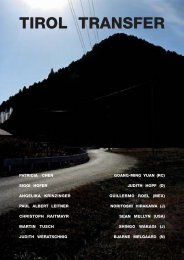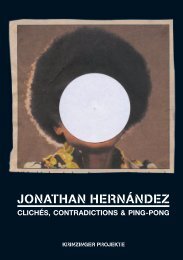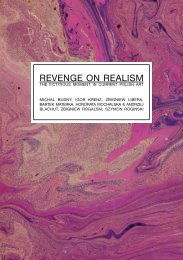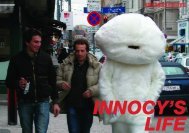post_modellismus – models in art - krinzinger projekte - Galerie ...
post_modellismus – models in art - krinzinger projekte - Galerie ...
post_modellismus – models in art - krinzinger projekte - Galerie ...
Create successful ePaper yourself
Turn your PDF publications into a flip-book with our unique Google optimized e-Paper software.
After Photography 1<br />
Five Model Cases<br />
by Ralf Christofori<br />
The question whether a photographic<br />
image depicts reality or creates its own<br />
pictorial reality is one of the central<br />
issues of contemporary <strong>art</strong>. The work of<br />
the <strong>art</strong>ists Laurie Simmons, Thomas<br />
Demand, Edw<strong>in</strong> Zwakman, Oliver Boberg<br />
and Lois Renner figures centrally <strong>in</strong> this<br />
connection. All of these <strong>art</strong>ists have <strong>in</strong><br />
common that they build <strong>models</strong> <strong>in</strong> which<br />
they (re)construct really exist<strong>in</strong>g or potential<br />
spaces and places. In each case<br />
the model is produced expressly for a<br />
photographic image. What ultimately<br />
rema<strong>in</strong>s is the photographic image of a<br />
place that no longer exists as such and,<br />
<strong>in</strong> fact, never really existed.<br />
It is this p<strong>art</strong>icular relationship of image,<br />
model and reality, which is a common<br />
feature of the work of the <strong>art</strong>ists named.<br />
It is important to note that these <strong>art</strong>ists<br />
refer to the quality of classical photography,<br />
deliberately dispens<strong>in</strong>g with the<br />
possibilities of the digital process<strong>in</strong>g of<br />
images. The manipulation of the image<br />
could be said to take place prior to photography.<br />
And yet this <strong>art</strong>istic strategy of<br />
creat<strong>in</strong>g photographs not of reality but<br />
of a model reality much more than just a<br />
deceptive ploy. Indeed, it captures the<br />
general assumption of photography, fulfill<strong>in</strong>g<br />
a representative function at its<br />
most vulnerable po<strong>in</strong>t: i.e., where it has<br />
to do with the credibility of photography,<br />
its specific possibilities of representation,<br />
that is to say the specific <strong>in</strong>terpretation<br />
which seems appropriate to photography.<br />
In short: it has to do with the<br />
prototypical prerequisites of photography<br />
which significantly def<strong>in</strong>e its production<br />
and reception.<br />
The question whether the photographs<br />
by Oliver Boberg, Thomas Demand, Lois<br />
Renner, Laurie Simmons and Edw<strong>in</strong><br />
Zwakman depict a model or reality certa<strong>in</strong>ly<br />
plays a decisive role. However, the<br />
<strong>in</strong>sight that the works are photographs<br />
of <strong>models</strong> does not lead to a def<strong>in</strong>itive<br />
conclusion. The US-American <strong>art</strong> historian<br />
Elizabeth Mang<strong>in</strong>i wrote the follow<strong>in</strong>g<br />
about Oliver Boberg’s photographic<br />
works: ‘Our <strong>in</strong>terest does not stop when<br />
we discover they depict <strong>models</strong>. In fact,<br />
the game only really beg<strong>in</strong>s then.’ 2 To be<br />
precise, it beg<strong>in</strong>s with the photograph<br />
try<strong>in</strong>g to make us believe that we are<br />
see<strong>in</strong>g the picture of a foregrounded<br />
reality. This is also the case <strong>in</strong> the works<br />
by Simmons, Demand, Zwakman, Boberg<br />
and Renner. But it is also not the case,<br />
s<strong>in</strong>ce this foregrounded reality only<br />
exists temporarily as a model. And this<br />
makes us become suspicious about the<br />
entire scope of this ‘game’ with which<br />
we are deal<strong>in</strong>g <strong>in</strong> these works. Thus the<br />
sure gaze of the observer draws support<br />
from the alleged specificities of photographic<br />
representation only to then, <strong>in</strong><br />
the next moment, call it <strong>in</strong>to question.<br />
10









